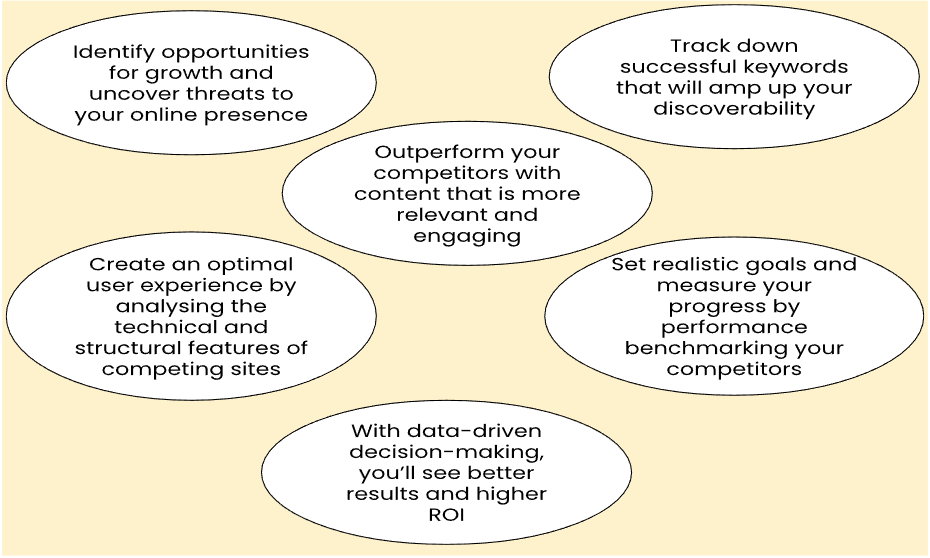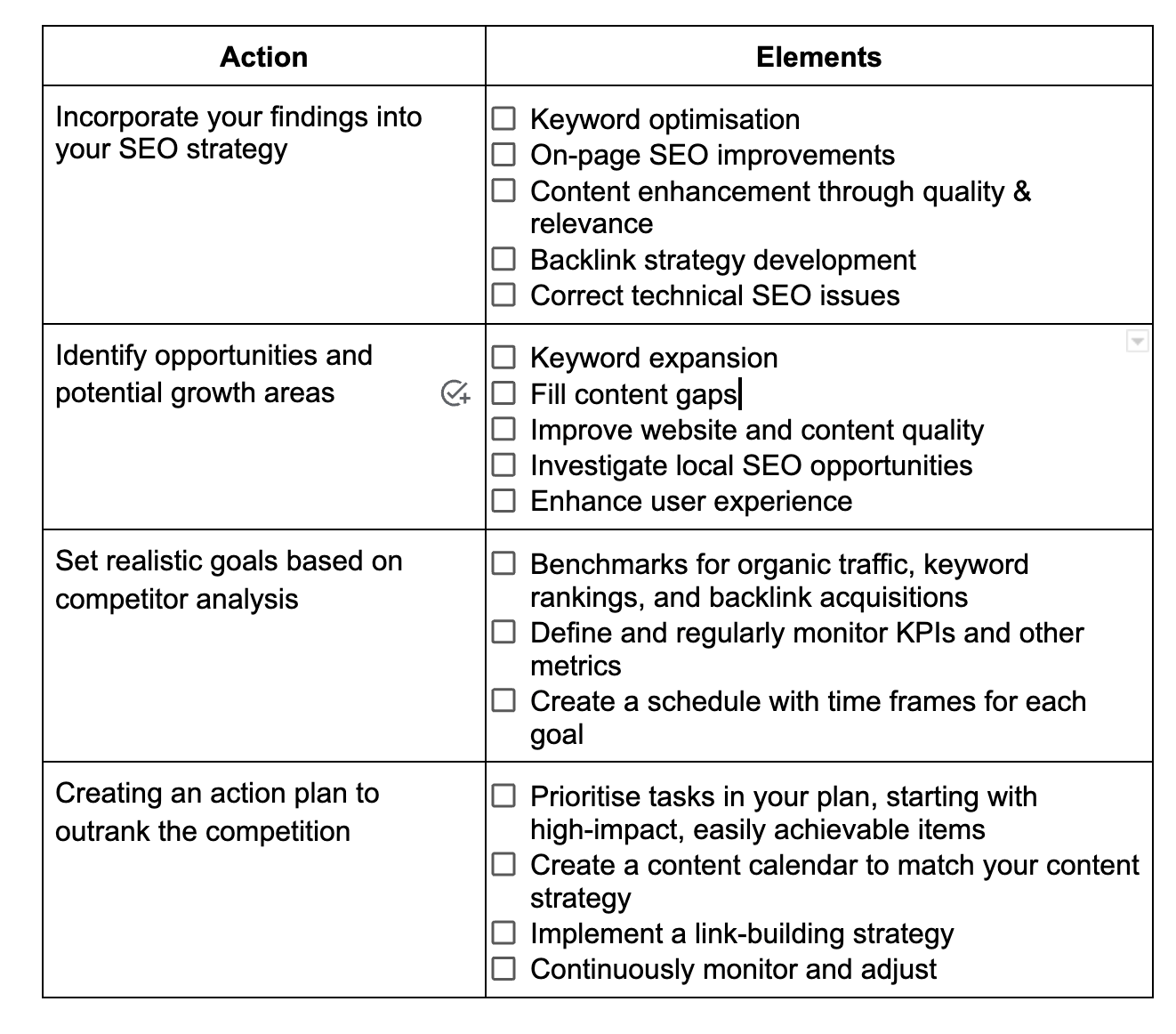Originally published November 14, 2023 , updated on November 30, 2023
Search engine optimisation (SEO) rankings are the yardstick of online success. An appearance on the first page of search engine results means you’ve made it, and your content game plan is on point. Now, the challenge is maintaining a visible online presence and ensuring the competition doesn’t outrank you.
A thorough SEO competitor analysis creates a roadmap to outperforming your rivals and strengthens your ranking. This will naturally lead to more organic traffic coming your way with solid leads to follow.
Understanding the Basics of an SEO Competitor Analysis
An SEO competitor analysis involves assessing the online presence, marketing strategies, and performance of your competitors in terms of search engine optimisation. By doing this, you’ll gain valuable insights into your ideal SEO approach and be able to adjust your content strategy accordingly. You’ll also confidently make well-informed decisions using backing evidence, with your search engine rankings escalating once you put the analysis to good use.
An efficient SEO competitor analysis plays a vital role when it comes to creating a robust SEO strategy. Check out some of the ways it can level up your game plan.

This would greatly benefit your business, but how do you find out who your competitors are? Start with some research. Plug relevant industry keywords into popular search engines and check out the pages in the results.
Many tools and platforms are available to help you identify sites that rank well for your primary keywords. Now, you just have to keep your eye on the enemy by regularly monitoring their SEO strategies and performance, allowing you to remain competitive.
Tools and Resources for Effective Competitor Analysis
As we’ve mentioned, several SEO competitor analysis tools are available to assist you in optimising your content strategy. Your choice depends on your needs – these could range from keyword analysis to backlink research to technical SEO auditing. Here are a few top-rated applications:
- Google Analytics and Search Console: These are free with features that include performance in terms of Google results, website traffic tracking, and user behaviour analysis.
- SEMrush: This comprehensive tool is a hit with the digital marketing crowd and provides keyword research, site auditing, and competitor analysis features.
- Ahrefs: Ahrefs has a robust backlink analysis feature and top-tier keyword research capabilities. This professional-grade tool has an interface geared more towards experienced digital marketers.
- SpyFu: Specialising in SEO competitor analysis, SpyFu will show you the keywords your competitors rank for and those they’ve bought through paid search. It’s been praised for its intuitive and easy-to-navigate interface.
How to Select the Right SEO Competitor Analysis Tool
The best SEO analysis tool depends on your specific needs and goals. Consider these factors before selecting:
- What are your objectives?
Define the specific data or insights you need that align with your goals and objectives in competitor analysis. Do you require customisation or flexibility? Ensure the tool will fulfil these needs.
- What’s your budget?
Price structures vary across the range of SEO competitor analysis services. Consider the amount you’d like to invest, bearing in mind that the cost should correlate to the value the tool provides.
- How user-friendly does it need to be?
Certain tools are targeted toward professionals in the digital marketing arena and may be harder to navigate for the less experienced. Intuitive navigation and user-friendliness could save you time while ensuring accessibility for most of your team.
- Will it integrate and grow with your business?
If you already have SEO tools in place, will the new tool be able to seamlessly integrate and communicate with your current toolbox? And in terms of scalability, will it grow as your business expands?
- Will the company provide the support and training you need?
The frustration of struggling to get through to IT support is real and detrimental to mental well-being. Consider the time and productivity lost if you can’t get that system glitch sorted out as soon as possible.
- How does the tool rate according to user reviews?
Check out what others say about the SEO competitor analysis tool on reputable review sites. Forums like Gartner, Capterra, and G2 usually provide reliable insight into what users have to say.
Choosing the perfect tool for your needs can significantly impact your SEO strategy. By carefully considering your budget and requirements, you could end up with an SEO competitor analysis tool that gives you a competitive edge in your industry.

Key Metrics and Factors to Analyse
Now that you’ve selected an SEO competitor analysis service, what exactly should you analyse? Have a look at the three basic elements you should consider evaluating.
1. Domain Authority and Backlinks
Developed by Moz, domain authority measures the strength and authority of a website’s domain name. It’s primarily determined by the quantity and quality of backlinks pointing to a site and is ranked on a scale of 1-100.
Backlinks are the inbound hyperlinks on other sites that lead visitors to your website. This is a fundamental element that can have a notable impact on your search rankings.
Both these elements are critical to your SEO competitor analysis as they affect your search rankings, competitive positioning, and link-building strategies.
2. Content Strategy: Keywords, Quality and Relevance
Valuable insights into your competitor’s content strategy will guide the approach of your digital marketing campaign. This is especially important when it comes to keywords, quality, and relevance. Consider the following:
- Keywords analysis:
- Identify high-performing keywords
- Discover keywords that are missing from your content
- Investigate your competitor’s use of long-tail/niche keywords
- Monitor their trending keywords
- Content quality:
- Take note of your competitor’s writing style, formatting, and depth of information
- Identify gaps in their content that will allow you to offer unique content
- Analyse their user engagement metrics. This could include the bounce rate, time on page, and social shares
- Pinpoint the content pieces that attract the most backlinks and referral traffic. Also, consider the number and quality of backlinks
- Observe their multimedia elements such as images, videos, etc.
- Content relevance:
- Is the content relevant to your industry and target audience?
- Does the search intent behind certain keywords align with the content?
- Is the content regularly updated to keep up with the latest developments?
- Does the content target the local audience with location-specific pieces and reviews?
By adjusting your SEO content strategy to fill the gaps left by competitors and providing quality content that delivers value and relevance, you’ll see a noticeable increase in your search rankings.
3. On-Page and Off-Page SEO Elements

On-page and off-page SEO elements are pivotal to your comprehensive SEO marketing campaign. They relate to your rankings in search results as well as your digital presence. Here are a few examples of each and what you should look out for:
- On-page elements:
- Keyword density in headings, body text, and meta tags
- Enticing page titles and meta descriptions
- Content structure with regards to header tags
- Clean and descriptive URL structure
- Internal links that connect to related pages on their sites
- Mobile-friendly, seamless use for smartphones and tablets
- Loading speed and overall site performance
- Off-page elements:
- Diverse referring domains with backlinks from authoritative and relevant resources
- Social media presence and engagement with users
- Online authority through brand mentions from other sites
- Competitor reviews and recommendations
- Media coverage through press releases and backlinks from news sources
- Affiliate and partnership programs
On-page and off-page elements should be viewed holistically – this way you’re able to see the entire package your competitors are offering and how it impacts their rankings. This helpful data will speak to your own content strategy and ensure you outperform your rivals in no time.
Step-by-Step Guide to Conducting SEO Competitor Analysis
Following a comprehensive, concise guide to analysing your competitor’s SEO strategy will ensure you won’t miss a thing. Here’s how we suggest you perform your analysis:
1. Identify Top Competitors in Your Niche
Start by having a clear understanding of your niche and the products, services, and topics that relate to it. Conduct keyword research to find your primary keywords and use these in search engines to see the top-ranking websites that pop up consistently. You could also invest in one of the SEO competitor analysis tools mentioned above to confirm your findings.
2. Analyse Competitor Keywords and Ranking Strategies
SEO competitor analysis services will help you identify the high-performing and long-tail keywords your competitors are successfully targeting. Now analyse these and consider the keywords for which your rivals rank and you don’t. Also, analyse their on-page and off-page elements that contribute to their performance. This includes the quality of the content, backlinks, on-page optimisation, and technical SEO aspects.
3. Understand Their Backlink Profile and Link-Building Strategies
Here, you want to investigate the quantity, quality, and diversity of their backlinks, especially those that originate from authoritative sources and those that are new to you. Analyse the anchor text in the backlinks – this will help you identify strong keywords and assist in your link-building strategy.
4. Assess Content Strategies and Identify Content Gaps
Evaluate the quality, relevance, and depth of information in your competitor’s content, focusing on high-performing items. By identifying the gaps in their content, you can fulfil a need and provide unique content that resonates with your target audience. As mentioned above, user engagement metrics will give you an idea of the content that is most engaging and relevant to users.
5. Monitor Social Media Presence and Engagement

Thanks to streaming services, television marketing is not as effective as it used to be. Now, grabbing your audience’s attention means having a social media presence that entices and engages subscribers while encouraging them to like, share, and comment on your content. Check out how often your competitors post and the type of content they offer. You can even invest in social listening tools to monitor online mentions and discussions about your competitor. It will also give you valuable insight into their online reputation.
SEO competitor analysis is not a once-off process. It requires constant monitoring to ensure you still have the competitive edge and that you’re leading the pack when it comes to new trends and developments.
Leveraging Insights for an Effective SEO Strategy
You’ve invested in an SEO competitor analysis tool, you’ve done your research, and, after your analysis, you have reams of data to consider. So, how do you use this to inform your content strategy? Read on to discover how.

Conclusion
When it comes to SEO competitor analysis, you don’t want to be left in the dust while your rivals ride off into the sunset with your potential customers. A thorough analysis will result in a strong content strategy that will have you outperforming your competitors and gaining a leading edge in your industry.
In essence, SEO competitor analysis will help you refine your content strategy and understand your position in the digital landscape. And with these insights, you can set realistic goals and create an action plan to get ahead of the competition.
So, where to begin?
Follow Goodman Lantern’s helpful guide in assessing who your competition is, analysing their on-page and off-page elements, incorporating your findings into your strategy, and continuously monitoring and adjusting.
Feeling overwhelmed?
Leave it to us. At Goodman Lantern, we’ll implement your plan with our professional team of writers, editors, and content strategists. Along with levelling up your content game plan, we’ll provide an SEO audit of your online presence with recommendations.
Contact us today for assistance with your SEO competitor analysis. We’re here to help!
Post Views: 83



















